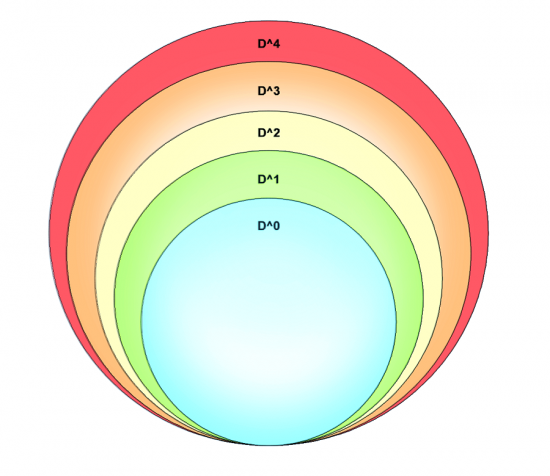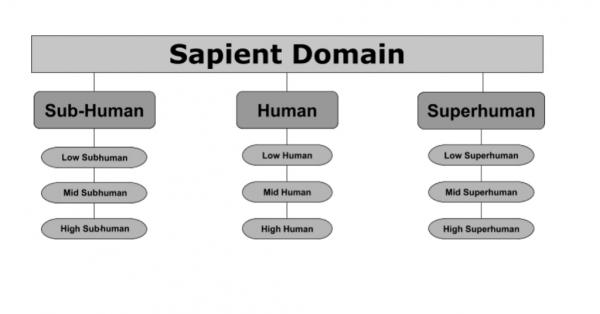BY LETTER
Forad Scale, The
Science > Sophontology > Toposophy > Singularity Levels
Science > Sophontology > Toposophy > Toposophic Scales
Science > Sophontology > Toposophy
Science > Sophontology > Toposophy > Toposophic Scales
Science > Sophontology > Toposophy
Alternative toposophic classification system | |
 Image from Todd Drashner | |
| The five domains of toposophy in the Forad Classification scale; Non-sapients, Sapients, Transapients, Godlings and Archailects | |
Early in the second millenium AT, superbright toposophologist Anedra Forad created a scale of intelligence loosely based on the ancient biological taxonomy chart. There was "life", then "domains," "kingdoms," and "phyla." In subsequent revisions, the labels of kingdom and phylum were eventually changed to "tier" and "sub-tier" respectively, because they were seen as too specific to biology. On this intelligence scale, domains signify the boundary which separates beings of different toposophic levels. Tiers represent differentials an order of magnitude smaller, while sub-tiers represent those an order of magnitude smaller yet. If the scale was analogous to a ruler, then domains would involve metric sizes, tiers would involve decimeter sizes, and sub-tiers would involve centimeter sizes.
Although e would come to move well beyond it, Forad based eir initial work on one of the oldest principles of toposophy: That sapients display fundamentally different types of thought from non-sapients. Self-awareness and language are defining features for them which non-sapients lack. Beginning from this foundation, it logically follows that transapients can have modes of thoughts that are completely alien to modosophonts. Forad's great work was to organize and categorize transapient abilities (i.e., domain features) such as foresight and ideogenesis into a consistent and readily accessible taxonomy. Prior to Forad, transapient modes of thought had been seen as largely undifferentiated either within or across Singularity levels, and no formal classification system existed.
Transapient mental abilities were widely seen either as 'mere' incremental differences in cognition or else so alien as to be un-quantifiable. In reality, they are very broad ranging modes of thought that are homologous to all beings of that domain and above. For example, while non-sapients posses the capacity to feel emotion, sapients demonstrate a wider range of more complex emotions. And while sapients posses self-awareness, transapients enjoy an awareness of self that is far beyond sapient capacities. Conversely, non-sapients do not possess language and sapients do not possess foresight. Overall, the mental abilities that are unique to transapients have little or no overlap with modosophont minds, which is what made them so difficult to perceptualise. Forad and eir team would spend many years reviewing thousands of hours of video, text, records and other studies in order to sift out the question "what makes this entity different from the others?" The result would come to be known as the Forad scale, and is used to this day
Initially, the scale would include only three domains, all described in detail. These were non-sapients, sapients, and transapients. An incomplete list of the features of each domain would include the following:
-Non-sapient: Cognition, sensation, emotion.
-Sapient: Self awareness, language, rationality, abstractness, numeracy.
-Transapient: Foresight, oversight, ideogenesis, translogic, autoscience.
 Image from Todd Drashner |
While this taxonomical classification was well received by the toposophy community, its overall philosophy was subject to criticism by some toposophologists. The scale seemingly ignored the importance of mind architecture. The most obvious example was how it was unable to quantify the intelligence of dedicated transvots, those strange artifices who drove much of Terragen civilisation. In addition, the emergence of S3 transapients indicated that the toposophic landscape was even larger than expected and extended beyond the bounds of the Forad scale as it existed up to that point. It was soon confirmed that these entities had domain features unknown to the S1s and S2s, modes of thoughts which could not even be vaguely summarized. Hence, the fourth domain of godling was added to the scale. The last canonical and accepted update was in the sixth millenium AT, resulting in a grand total of five domains.
D^0 domain = Non-sapients.
D^1 domain = Sapients.
D^2 domain = Transapients (S1 and S2 transapients).
D^3 domain = Godlings (S3 and S4 transapients).
D^4 domain = Archailects (S5 and S6 transapients)
Related Articles
- AI God - Text by M. Alan Kazlev
Popular term for the most sublime category of sentient being in the known galaxy: an Archailect or archailect cluster grown to godlike status. Something of a misnomer since in fact that not all archailects are primarily ascended ais; most are complex multibeings and incorporate postbiont or postvec elements. - Autosentience, Autoscience
- Foresight
- Ideogenesis
- Oversight
- Sapience
- Sentient - Text by Stephen Inniss
As an adjective, having the characteristics of sentience. As a noun, particularly in the plural, any being that is deemed to have sentience, as in "The Universal Bill of Sentient Rights". - Sophonce
- Sophont - Text by Stephen Inniss
A person. A being that has the quality of sophonce. Such beings are sometimes called 'sapients'. For historical reasons, sophont-grade ais, may be called 'turingrade ais', even though because of philosophical and practical difficulties with the Turing Test the term 'sophont ai' would be clearer. - Translogic
Appears in Topics
Development Notes
Text by James Philps
Todd Drashner, Selden Ball
Initially published on 17 January 2017.
Todd Drashner, Selden Ball
Initially published on 17 January 2017.






